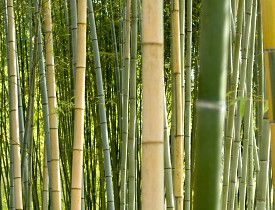5 Reasons Not to Plant Bamboo in Your Yard
 Bamboo is a trendy star of the eco-friendly construction movement, with a wide variety of flooring, furniture and other items being manufactured from the strong, fast-growing grass. However, bamboo production should be left to commercial growers. Bamboo’s hardiness and rapid growth make it a problematic plant for most yards. Here are the top five reasons not to plant bamboo in your garden.
Bamboo is a trendy star of the eco-friendly construction movement, with a wide variety of flooring, furniture and other items being manufactured from the strong, fast-growing grass. However, bamboo production should be left to commercial growers. Bamboo’s hardiness and rapid growth make it a problematic plant for most yards. Here are the top five reasons not to plant bamboo in your garden.
1. Bamboo can spread into neighboring yards.
Many homeowners plant bamboo to create a fast-growing privacy screen around their home. Ted Jordan Meredith, author of Bamboo for Gardens, notes that some bamboo species grow more than three feet per day. Bamboo can spread as quickly as it grows, and it doesn’t respect fences or property lines.
Bamboo grows particularly vigorously when adjacent to irrigated lawns and gardens or in low-lying areas that collect water. Instead of just blocking the view of nosy neighbors, you could be turning your property line into a war zone by planting bamboo.
Some bamboo species may even be categorized as noxious weeds, meaning a neighbor could legally force you to remove your bamboo. You could also be liable for the cost of any damage to the neighbors’ property caused by your bamboo, and for the cost of removal from their property.
2. Bamboo can be an invasive threat to biodiversity.
Bamboo that spreads and escapes your yard may cause ecological problems as well. Many spreading bamboo species are categorized as invasive exotic plants that crowd out native plants and threaten biodiversity.
The best ways to contain spreading bamboo tend to be expensive and complicated, and may not be worth pursuing for many homeowners. Moreover, they are not foolproof. Experts at the University of Georgia Cooperative Extension recommend burying thick 60-mil polypropylene or fiberglass about three feet deep, and leaving another two inches of material above the soil to inhibit surface spreading. Morgan Judy of Clemson University Cooperative Extension suggests creating a solid barrier made of concrete, metal or pressure-treated wood at least 18 inches deep around the bamboo.
Any of these barriers should stop shallow bamboo rhizomes from spreading, but Judy still recommends closely monitoring the area for escaping shoots, particularly during the early summer peak growing season.
3. Getting rid of bamboo can take years.
Bamboo is a long-term relationship that should not be entered lightly. It may take years and vigorous effort to remove unwanted bamboo. The first step in removing bamboo is to remove all the root mass and rhizomes. This is easier said than done, and many homeowners with bamboo-loving neighbors complain they can’t get rid of the spreading grass. No matter how much they dig, the shoots keep coming back.
Judy suggests frequent mowing can deplete and starve the bamboo, but it take at least two years of regular mowing to see any results.
4. Getting rid of bamboo may require herbicides.
Moreover, Judy notes that chemical herbicides are often necessary for controlling bamboo. This can be a problem for those trying to maintain organic gardens and avoid herbicide use.
Judy recommends Roundup Original, Quick Kill Grass and Weed Killer and other herbicides containing glyphosate. This broad-spectrum herbicide has minimal residual soil activity and typically only kills the plants that are directly sprayed. Mow or chop the bamboo and let it regrow until new leaves expand. Then spray the herbicide on the leaves.
Again, this could take years. One application will not solve your bamboo problem. Also, Judy warns that specialized glyphosate herbicides should be used near creeks, ponds and other surface water. Eraser AQ, Pondmaster and other products are approved for use near water.
5. The right bamboo can be hard to find.
Bamboo’s defenders will argue that not all of the more than 1,000 bamboo species are equally invasive. They recommend clumping bamboo species rather than spreading types. The problem is that even clumping species spread, albeit not as vigorously. It also can be hard to differentiate between the types, and some are mislabeled. Moreover, other similar invasive species may be confused with bamboo. For example, University of Arizona Cooperative Extension officials warn against transplanting or encouraging the giant reed (Arundo donax), a bamboo look-alike that has invaded parts of their state.
Bamboo may seem like an attractive garden option, but it poses serious problems. Stick to a lucky bamboo in a small indoor pot, or avoid growing bamboo altogether. Moreover, do your homework before buying bamboo flooring and other products. It may not be as eco-friendly or durable as you think.
For expert help in removing bamboo, hire a professional landscaper.
Looking for a Pro? Call us (866) 441-6648

Landscaping Average Costs
Landscapers Experiences

I Built A Concrete Retaining Wall As A Defense Against El Nino

Tree Removal So Fast And Efficient It Didn’t Even Wake Our Newborn



